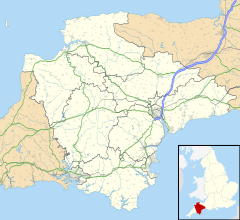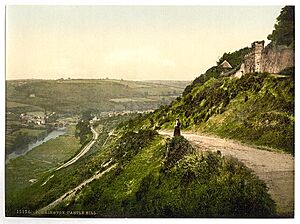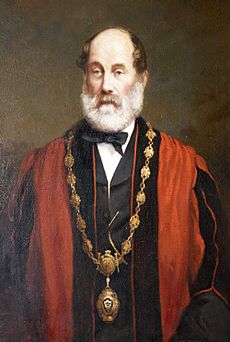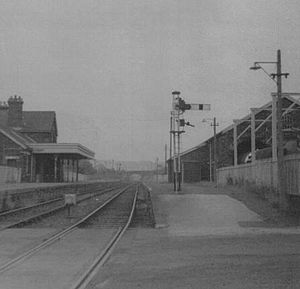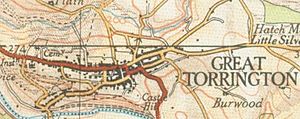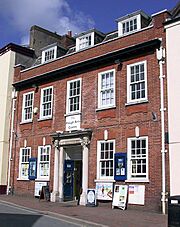Great Torrington facts for kids
Quick facts for kids Great Torrington |
|
|---|---|
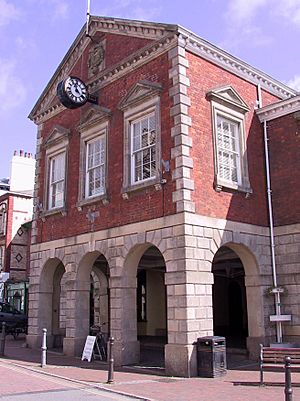 Great Torrington Town Hall in the centre of the town |
|
 Coat of arms |
|
| Population | 5,953 (2021 Census) |
| OS grid reference | SS4919 |
| District |
|
| Shire county | |
| Region | |
| Country | England |
| Sovereign state | United Kingdom |
| Post town | TORRINGTON |
| Postcode district | EX38 |
| Dialling code | 01805 |
| Police | Devon and Cornwall |
| Fire | Devon and Somerset |
| Ambulance | South Western |
| EU Parliament | South West England |
| UK Parliament |
|
Great Torrington, often called Torrington, is a market town in Devon, England. It is built on high ground, with steep slopes leading down to the River Torridge. Some lower parts of town can sometimes flood.
Torrington is in 'Tarka Country', an area made famous by Henry Williamson's 1927 book Tarka the Otter. The town has one of the most active volunteering communities in the United Kingdom. In 2019, Great Torrington was even called the healthiest place to live in Britain! This was because it had clean air, lots of green spaces, good health services, and not too many shops.
Contents
Town History
Long ago, during the Iron Age and Middle Ages, castles and forts stood on Castle Hill in Torrington.
Great Torrington was very important during the English Civil War. In the Battle of Torrington in 1646, the Parliamentarian army, led by Sir Thomas Fairfax, defeated Lord Hopton's Royalist forces. This battle ended the Royalist fight in the West Country.
Today, Torrington is known as an important place for 17th-century history. People often dress in costume for re-enactments, festivals, and celebrations. An interactive experience called "Torrington 1646" helps visitors learn about the town's role in the Civil War.
During the battle, the Torrington jail was too small. So, the Royalists kept Parliamentarian prisoners in the church. Then, 70 barrels of gunpowder exploded. This killed everyone held captive and many of their captors. The Great Torrington Town Hall, a beautiful neoclassical building, was finished in 1861.
The Railway Story
The railway line from Barnstaple to Bideford reached Great Torrington in July 1872. The London and South Western Railway built a station and a place for locomotives here. The station was always called 'Torrington'.
The locomotive depot closed in 1959. The line stopped carrying passengers in 1965 as part of the Beeching Axe, which closed many railway lines. It stopped carrying goods in 1984.
Today, a pub called The Puffing Billy stands at the old station site. Most of the tracks have been removed. They are now part of the Tarka Trail, a path for walking and cycling. The Tarka Trail goes for 32 miles (51 km) without traffic. It connects Torrington to Bideford, Barnstaple, Braunton, and Meeth.
Torrington Common
Torrington Common is a large area of common land that surrounds the town on three sides. A group called "The Commons Conservators" manages this land. The Common covers 365 acres (1.5 km²) and has over 20 miles (32 km) of public paths. It has many different types of plants and animals.
History of the Common
In 1194, an "area of waste called the Common" was given to the town by the local feudal baron. In 1889, an act of parliament gave the rights to this land to an elected "Committee of Conservators". This group has met regularly since October 2, 1889, to manage the land.
At first, they mainly controlled grazing and quarrying. But since 1980, grazing has stopped. Now, they use other methods to keep the common from becoming overgrown with bushes and trees. Some building has happened on the common, which some local people do not like.
Common Features
- Taddiport Bridge and Rothern Bridge: Before the Town Mills Bridge opened, these were the only ways to cross the River Torridge nearby.
- Rolle Road: This road follows the path of the Rolle Canal. The canal opened in 1827 to move clay, lime, and other goods. It connected boats on the tidal river to kilns and farms around Torrington. The canal closed in 1871 and was filled in to create a toll road.
- Waterloo Monument: This stone obelisk was put up in 1818. "The ladies of Great Torrington" built it to remember the Battle of Waterloo.
Fun Things to See and Do
Things to see and do in Great Torrington include:
- Dartington Crystal: This is the biggest employer in town. You can visit the factory, see glass being made, and shop for beautiful glass items.
- Rosemoor Garden: These lovely gardens, woodlands, and parkland are owned by the Royal Horticultural Society.
- The Victorian Torrington Pannier Market: This market has a glass roof and was restored in 1999.
- Great Torrington Heritage Museum: Located next to the Pannier Market, it tells the town's story.
- St Michael and All Angels: This Church of England parish church has a churchyard. A mound there is said to hold the remains of 60 Civil War Royalist prisoners.
- The Plough Arts Centre: A small theatre, cinema, and art gallery.
- Great Torrington also has many pubs that serve food and local real ales. These include The Torridge Inn, The Black Horse, Torrington Arms, Cavalier, Globe, and Royal Exchange.
Jobs in Town
Torrington has always been a town with factories. In the 1800s, it was a big center for making gloves. Today, Dartington Crystal is the main employer. Shops in the town center also provide jobs. Most shops are locally owned, but there are also branches of The Co-operative Food, Lidl, Spar, and Lloyds Pharmacy.
Some large factories have left the town recently. A meat factory closed after a fire. A milk factory also had a fire and moved its production elsewhere. Many care homes in the town also provide a lot of jobs.
In 2006, Tesco wanted to open a large store in town. However, many locals were against it, and the plan was rejected.
Sports and Culture
Local radio is provided by The Voice. This station is based in nearby Barnstaple and broadcasts across North Devon. Most of its shows are made locally.
Local news and TV shows come from BBC South West and ITV West Country. TV signals are received from the Huntshaw Cross transmitting station northeast of town.
The BBC Local Radio station for the town is BBC Radio Devon on 94.8 FM.
The regional radio station Heart West can also be heard. It is part of the Heart network and broadcasts across the South West of England. Most shows are national, but some are regional, like the weekday Drivetime show from Bristol.
The local newspaper is the North Devon Journal, also based in Barnstaple. The Western Morning News is a regional paper widely available. Most homes get a free copy of the North Devon Gazette every week. The Crier is a community newsletter delivered free to most homes in the area ten months a year.
Torrington's football teams are Torrington F.C. and Torridgeside A.F.C.. There are also rugby, netball, tennis, and swimming teams. Torrington's nine-hole Golf Course is 1.2 miles (1.9 km) northwest of the town center. Great Torrington Bowling Club, started in 1645, is the third oldest bowling club in England.
Great Torrington is twinned with Roscoff, a French port town in northern Brittany. Roscoff is a popular place for school trips from the area.
Getting Around
Torrington has 43 local bus services, mostly run by Stagecoach South West. Some services only run one way, and some are weekly.
Belle Vue Airfield is a small airfield about 2.5 miles (4 km) northeast of Great Torrington. It is for private planes only, like microlights and hang-gliders. The runway is grass and 580 meters (1,902 feet) long.
Exeter Airport, 35 miles (56 km) away, has flights to Shannon Airport in Ireland and the Channel Islands.
The closest ferry port is Plymouth, 40 miles (64 km) away. From Plymouth, Brittany Ferries offers regular service to Roscoff in Brittany. There is also a summer-only ferry service from Bideford Harbour (7 miles away) to Lundy Island.
Torrington does not have direct train services. Umberleigh, 8 miles (13 km) away, is served by the Tarka Line from Exeter St David's. You can get a bus to and from Barnstaple station, which is 11 miles (18 km) away.
Famous People
- Thomas Fowler (1777–1843), an inventor.
- Elizabeth Johnson (1721–1800), a writer of pamphlets.
- William Johnson Cory (1823–1892), an educator and poet.
- William Keble Martin (1877–1969), a reverend, botanist, and author.
- William Sandford (1841–1932), a pioneer in the Australian iron and steel industry.
See also
 In Spanish: Great Torrington para niños
In Spanish: Great Torrington para niños


